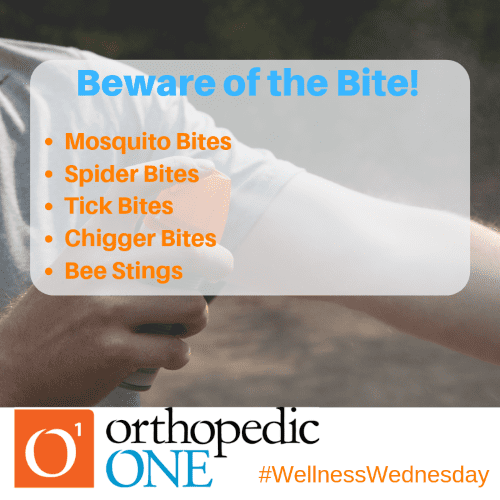Beware of the Bite!
While summer brings warm weather and the opportunity to participate in lots of fun outdoor activities, not coincidentally, it is also the time of year when bug bites and bee stings increase.

Check out the tips below to learn more about these pesky issues, as well as treatment and prevention options:
Mosquito Bites
- Fun fact: Only female mosquitoes bite.
- Symptoms: Can include a puffy, white and reddish bump or a hard, itchy, reddish-brown bump that appear from a few minutes to a day or so after the bite.
- Treatment: Attempt not to scratch the bite, apply an OTC hydrocortisone cream, take anti-histamines, apply a cold compress.
- Prevention: Use insect repellent, avoid certain hours when they are most active (dusk till dawn), wear long sleeves and pants when outdoors.
Spider Bites
- Fun Fact: There are only two spiders in the United States that are venomous, and they seldom bite.
- Symptoms: Tiny, red bumps that are sometimes painful and itchy with associated swelling around the bite.
- Treatment: Depends largely on the type of spider you were bitten by. The vast majority of spider bites are from non-venomous spiders, but if you do get bitten by a spider, try to catch it so it can be identified and direct the correct course of treatment. Clean the affected area with soap and water and apply an antibiotic ointment. OTC pain relievers and antihistamines will help with pain, swelling and itchiness.
- Prevention: Be aware of your surroundings, check the attic and garage for webs, wear long sleeves and pants when in wooded areas.
Tick Bites
- Symptoms: Can include fever/chills, aches and pains, swelling around bite location, rashes.
- Bite locations: Are common in and around the hair and ears, under the arms, in belly button, around waist, between legs, and back of knees.
- Treatment: Common symptoms can be treatable at home with antibiotics.
- Removal: Use fine-tipped tweezers and grasp tick as close to skins surface as possible, pull straight out with steady even pressure. Do not twist or jerk as this may cause parts to break off.
- Prevention: Treat clothing with .5% permethrin, avoid wooded and brushy areas with high grass and leaf litter, walk in the center of trails.
Chigger Bites
- Symptoms: Intense itching that can keep you up at night, bumps and blisters. Note, obsessive scratching can lead to infection.
- Treatment: Take a shower and scrub skin with soap and water to wash any chiggers that may still be on you. Apply an OTC anti-itch cream such as hydrocortisone, take an antihistamine or use a cold compress to relieve itching. In extreme situations, you may need a steroid shot to calm the itching and swelling.
- Prevention: Use bug sprays such as DEET or permethrin, wear long sleeves and pants when in wooded or grassy areas.
Bee Stings
- Fun Fact: Common bees include honey, carpenter and bumble bees, as well as wasps.
- Symptoms: Common symptoms include redness around the sting site, pain, swelling and itching. More serious symptoms may include vomiting, nausea, dizziness, difficulty breathing and sudden drop in blood pressure.
- Allergic Reactions: If you have a known allergy and get stung by a bee, please seek advanced medical treatment immediately. Anaphylactic reactions usually occur within minutes of being stung. If you have a known allergy, keep an Epi-pen within reach.
- Treatment: Remove the stinger if visible in the wound, apply ice or cold packs, clean the area with soap and water, take an antihistamine.
- Prevention: Do not swat or swipe at bees! Rather, blow. They normally only sting when they feel threatened. If you leave them “bee”, they will leave you alone!
Sources: Centers for Disease Control, The Digest, DrGreene.com, Health.com, KidsHealth.org, Mayo Clinic, MedicineNet, WebMD.com